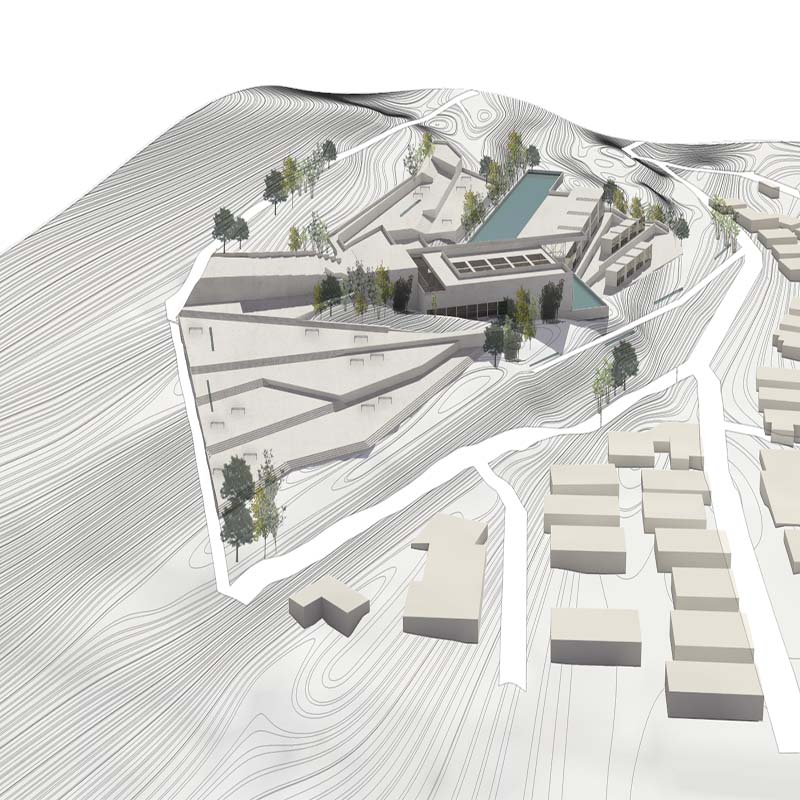

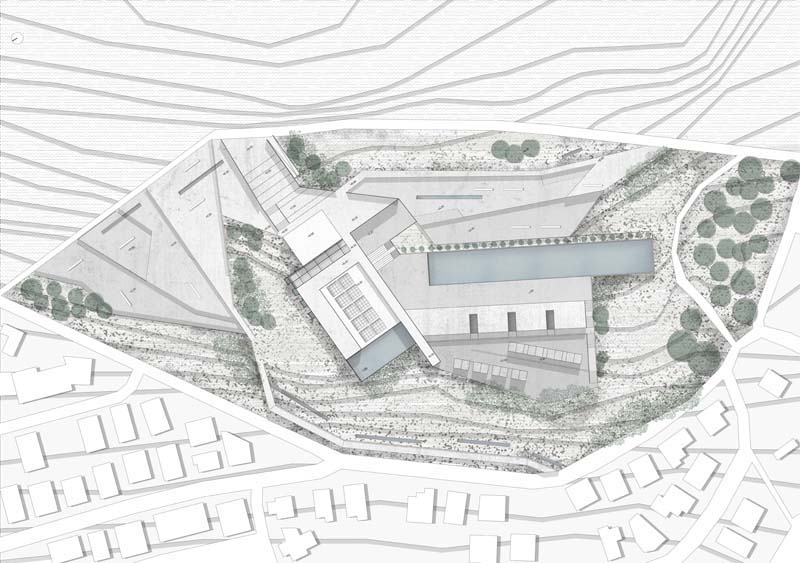

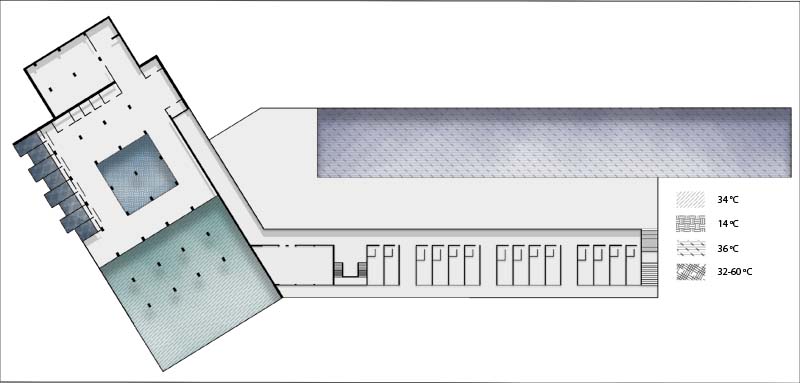

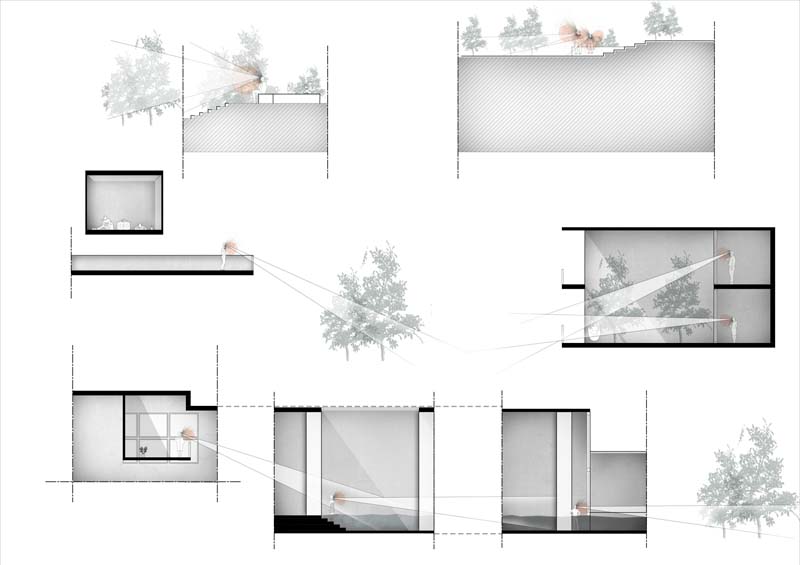





Aixoni is one of the suburbs of Ano Glyfada. It is bordered west by Vouliagmeni Avenue and south by Ano Voula. This is an area with undulating landscape, as it is located on the southwest slope of Mount Hymettus, and with a fairly high value of land, due to the proximity to the mountain and the unobstructed view of the Saronic Gulf. Architecturally, it is related to the work of Pikionis during the 50's but also with the sculpture theater of Aixoni designed by the architect and sculptor Nella Golanda. Subsequently, in 2017, a Greek government gazette was published that delimits and identifies a thermal spring in the area.
In light of the above, the present work deals with the design of a thermal bath and hospitality facilities unit, which offers services to both visitors and guests of the hotel. It is a place of relaxation and hydrotherapy that one can visit for a few hours or a few days. The basic joined idea arose from the steep slope of the ground, the view and the orientation of the plot.
The synthesis consists of two main volumes, one of the hotel unit and a semi-cave one for the bath facilities. The dome of the bath facilities functions as a square for the area having a direct view of the city of Glyfada and the sea.
The reception level is at the level of the rooms, on the edge of the square. From there, guests can head to the accommodation area or to the baths. In the bath unit there are private and communal tanks with thermal water at different temperatures. Outside there is a large communal tank that is the center of the synthesis. In addition, massage rooms, a gym and a restaurant were designed in the volume of the baths. The volume of the hotel was divided into two zones, the main building and independent rooms on two floors. Downstairs, in the main building, there are the dining and ancillary areas.
Supervisor: Paniyiris Costis
Reference Number: 875
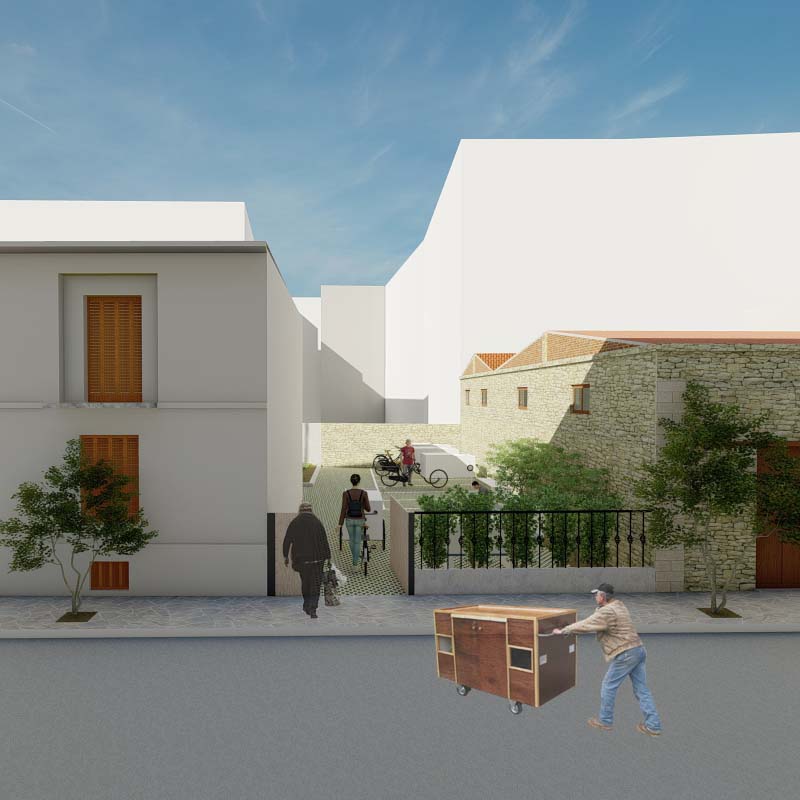

The diploma thesis, with field of research the city of Volos, begins with the creation of a Survival Guide for the city of Volos, which records solidarity practices and protection structures, housing services, medical care, social services, clothing services, detoxification, psychological support and SOS lines. Then, through the exploration for homeless people in our city and the places where they prefer during the period of their homeless life, a wandering in the abandoned buildings took place, as possible places of residence. The area of Metamorphosis was selected as the study area and then these points were mapped, with the research finding an example of a homeless person living in an abandoned house. So, through conscious choice, I was led to reuse specific abandoned buildings as hubs for resettlement. The homeless is an active subject of architectural design with the aim of safe living, which will extend to the public space and will be an urban mechanism of the homeless in the city. It is a residential network in abandoned buildings with design intervention but also with the integration in their surrounding area with small houses that will be used by vulnerable groups.
Supervisor: Vyzoviti Sophia
Reference Number: 894
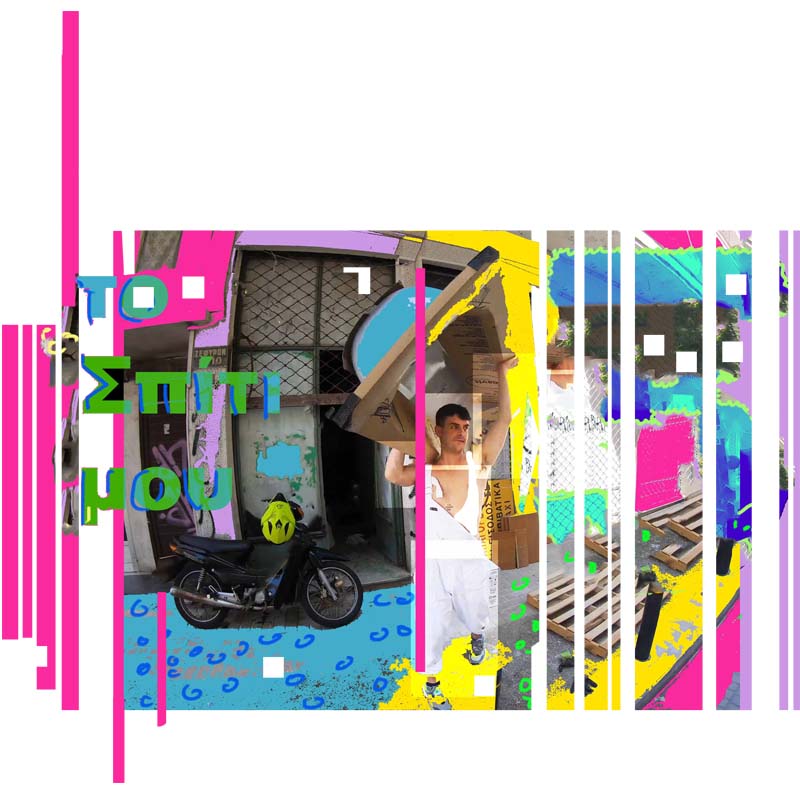

This dissertation is about how I built my house in Thessaloniki. I list in detail all the process of finding, designing and building my house. Given the financial difficulties and the unfavourable economic situation of Greece, it was difficult for me to rent an apartment. After some research I found a place that felt suitable for my needs and I decided to transform it into a fully functional residence.
Specifically, the place I found is an old warehouse in the historic centre of Thessaloniki. It has a glass front and metal shutters. It was an undivided room with a small loft. Its dimensions are 1.90 by 8 and 4 meters high. After spending a lot of personal time and putting a lot of effort I managed to install electricity, water, internet and connect the bathroom to the sewerage system. I designed and built my staircase, bathroom, kitchen and room. Since there wasn’t much space I had to improvise so I created a moving wardrobe that depending on its position defined the area of kitchen or bathroom respectively.
In this assignment I am describing the experience itself and provide information beyond the stages of design and technical materialization of the project. Therefore I include my experience with people I interacted with or helped me during the process. Additionally, I created a few vlog videos throughout the building process, which are available for everyone to watch.
Supervisor: Papadimitriou Maria
Reference Number: 870
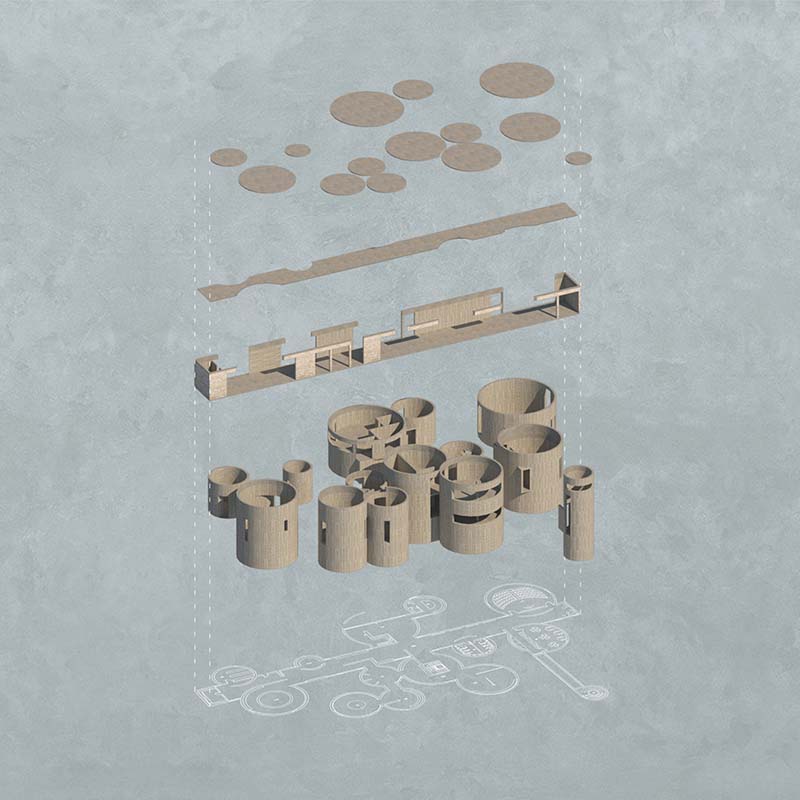

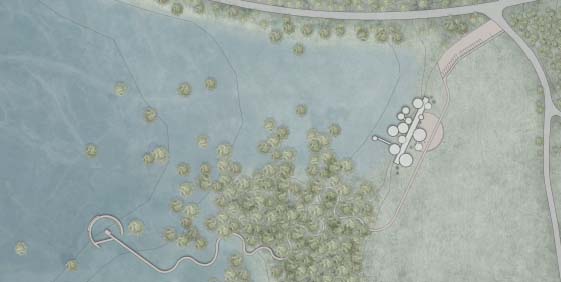

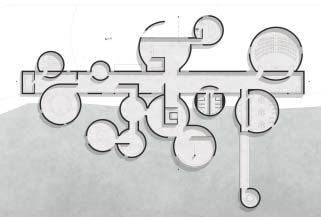

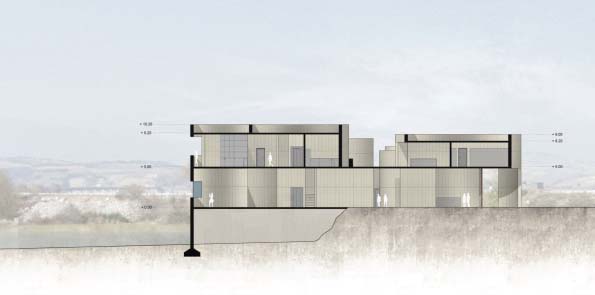

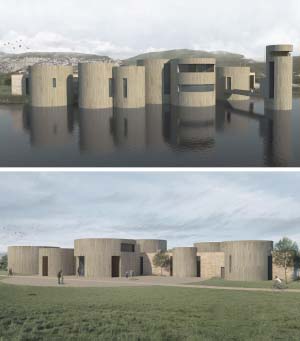

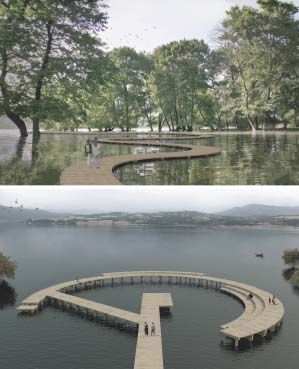

This diploma thesis presents a possible design approach to a Natural History Museum in the wider Aliakmonas River area. The proposal is based on the existing Historical-Folklore & Natural History Museum locatedin the city of Kozani. The choice of the theme came up from the desire to promote and develope the natural beauty and wealth of the region of Aliakmonas, as it is one of the richest water sources in Western Macedonia, and one of the most important habitats in the country. The Museum was located in the area of the artificial lake of Polyphytos, which crosses the river Aliakmonas, on a special bank, with the unique view of the flooded plane trees. The location is directly accessible from the main ring road. The design was influenced and guided by the surrounding space and its specific features, and was developed on two levels. The first concerns the museum building, and the second has to do with the lakeside route that ends at the circular pier. Thus, the space acquires a public character that can accommodate the locals and attract visitors, in order to get to know better the place and its natural history, both with the exhibits and functions of the museum, as well as with the walking path exploring the forest and enjoying the landscape.
Supervisor: Manolidis Kostas
Reference Number: 866
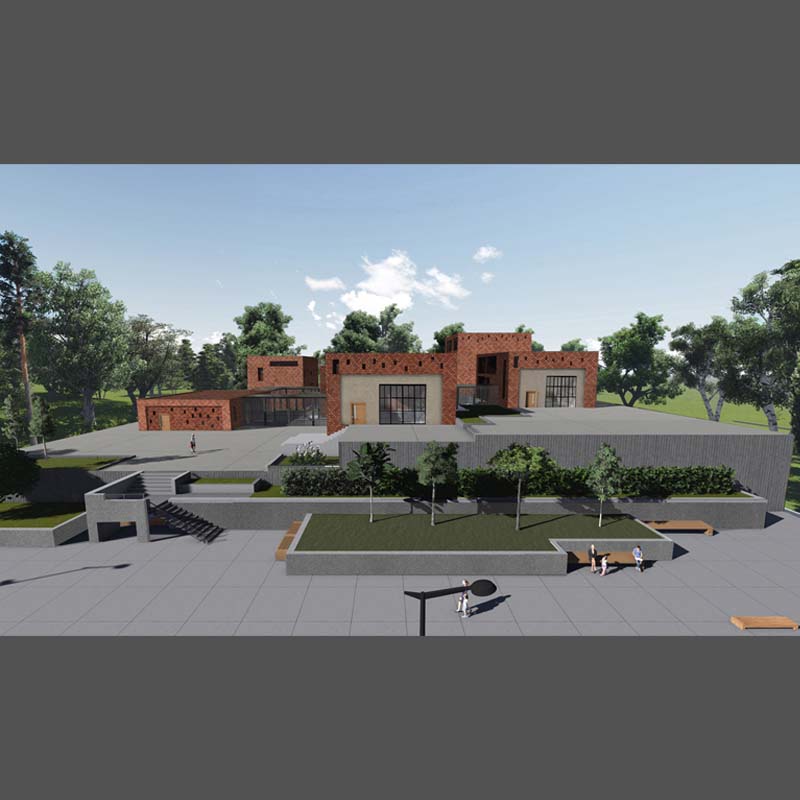

The current thesis focuses on thedesigning of a construction project at the Cedar-covered- hill area, now known as Seih Sou in our days, in the north-eastern part of Thessaloniki. It is about the reconstruction, redesign and use of an old Café, once used as the house of the forest guard. The project aims at the configuration of a complex of buildings that includes, an awarding scholarship hall for students of schools of Art, an art exhibition venue, and also a guest accommodation. A pole of cultural and artistic interest for the whole European academic community.
The distance and its proximity to the two University City institutions, makes that place, an ideal choice. It can also be a motivation for the art-loving city dwellers to visit, willing to admire the art exhibitions and also enjoy a stroll in the green forest with the unique city view of Thessaloniki.
The building structure of the project consists of two basic structural elements;the reinforced concrete and the metal. The main volume of buildings consistsof reinforced concreteand brick coating. Arcades built with metalglass and grid are placed outwardly, contributing to the buildings’ connection. The visual effect of that process, places this project (at its own environment, with respect towards it and adapting this to the colour palette/ places this project with environmental respect, adapting it to the colour palette).
In the premises of the building complex, competitions, art presentations, lectures and screenings, are to be held while the possibility of accommodation will be offered to visitors. These actions will take place in a building complex (communicating by) linked through arcades while the windows of the spaces are placed in such way so as to give the feeling of continuation with the external space. In the outdoor environment there are green spaces in order to achieve a possible visual continuity of the complex along with the forest natural habitat.
The purpose of this construction ideais to give students the opportunity of distinction through competitions and exhibitions that are taking place in those premises, with the ultimate goal, of the international promotion of their work, achievement which will contribute to their professional rehabilitation and integration into the professional arena by offering them employment opportunities.
Supervisor: Adamakis Kostas
Reference Number: 905


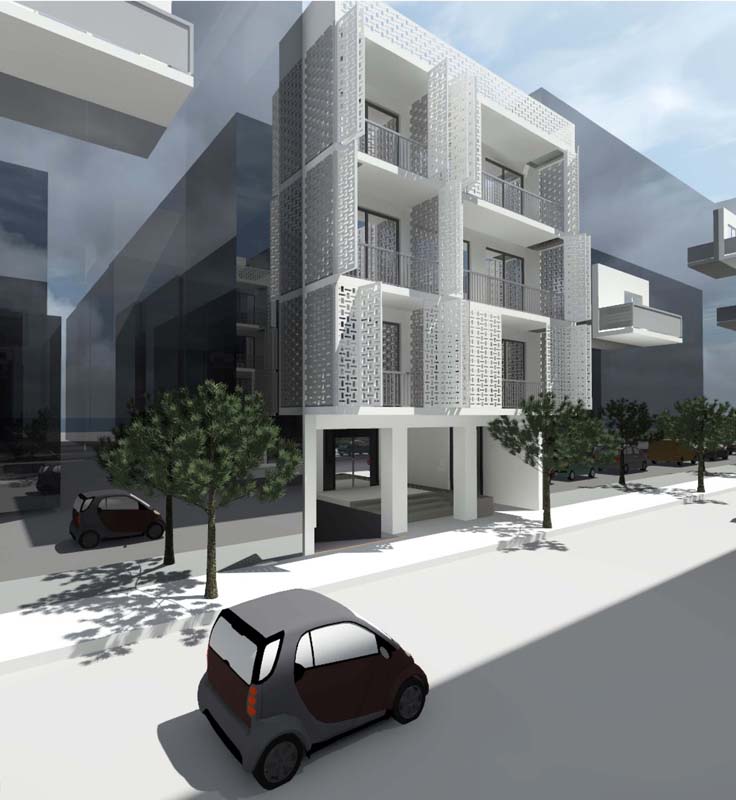



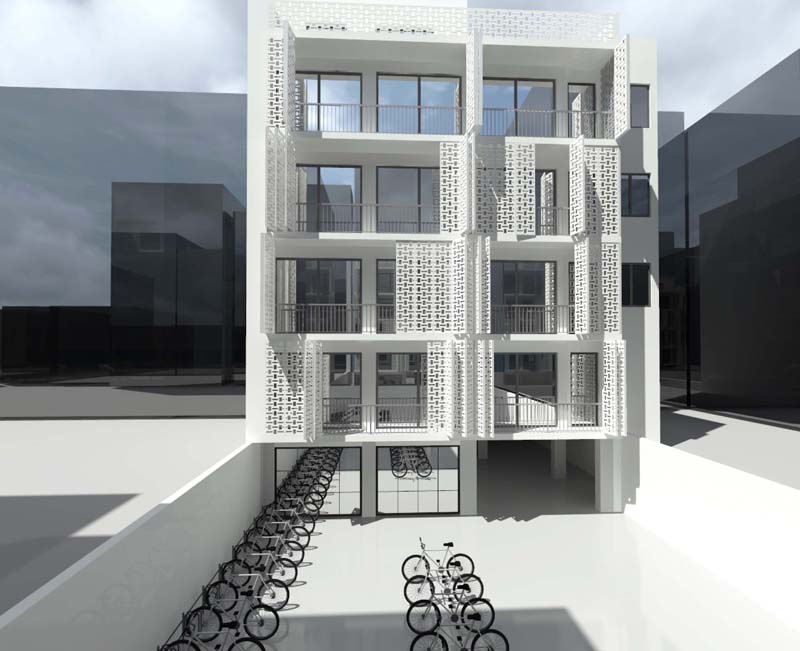

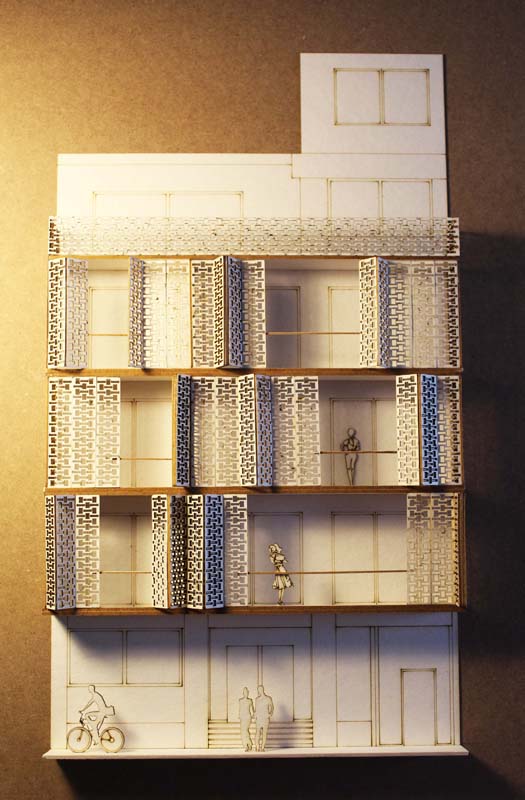

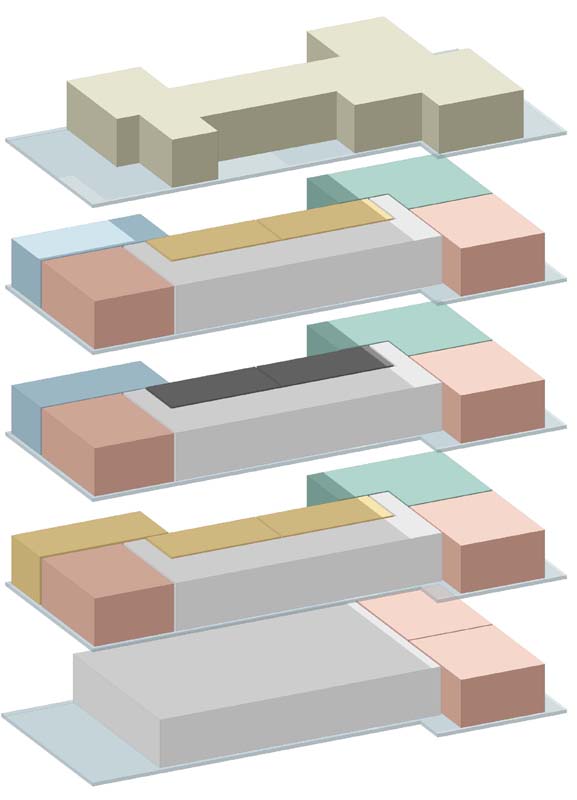

The present dissertation ¨Co-accommodation - operation in an installed hotel unit in the center of the city of Larissa is the result of a research that along the way filled me with knowledge, experiences and new friends.
My research in the center of Larissa testifies to the old glamor with the majestic hotels that are hidden in the web of the city.
Others in operations are still trying to cope with the points of the carts and others, well hidden behind their abandonment, are waiting for the moment when they will reopen. The years that have passed have shown that these majestic buildings with the numerous rooms in many cases are no longer profitable to be managed by their owners, who in most cases are more than two people.
The building under study is located in the center of Larissa and has been waiting for years. It is adapted to the elongated plot, hiding in it a capacity and energy.
Today's society is redefining the concept of regularity in living. The data and the needs have changed and the architect is called as never before to provide a solution to the new needs that arise at a fast pace.
The philosophy of co-habitation is strengthened by expecting in a society that strengthens the sense of cooperation for a common goal, the evolution of man at all levels. Cooperation is a skill that in Greece may have been pushed aside by giving priority to autonomy. An individuality that was cultivated to such an extent with the obvious results of today's society
The proposal in the building under study initially gives new life to the abandoned building, with respect to its mixed use and strengthening the new facilities with flexible and functional spaces, which are adapted and help in a pleasant stay of the tenant.
Supervisor: Gavrilou Evelyn
Reference Number: 848
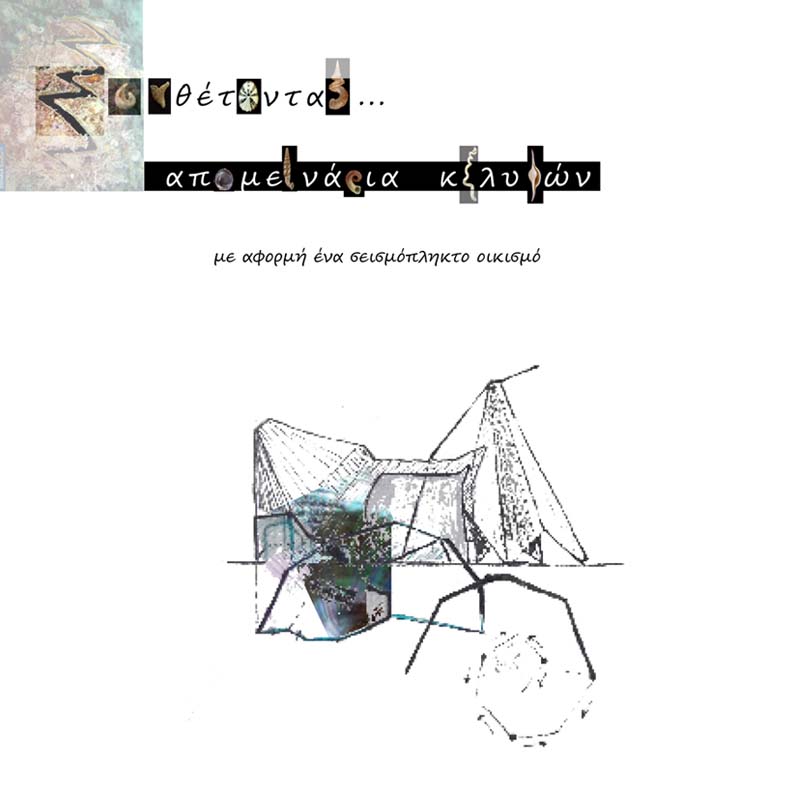

As in fairy tales, so in natural world of the seabed, there is exaggeration and extreme differences in size. The small invertebrates, the well-known “snails” that engaged in research (gastropods and bivalve mollusks), have shells that from 5 mm can reach up to about 1 meter. By losing their shell, they are looking for another one. Sometimes it gets injured, so it changes shape and becomes now a “remnant”- shell.
The fragmentation of a shell in combination with the earthquake of 2017 that struck the traditional settlement of Vrisa, Lesvos, is what basically shaped the course of research and ultimately the design of this dissertation. Specifically, the village was deserted and most of the residents moved to hotels in the nearby resort - and recently developed tourism - settlement, in Vatera. In one of the earthquake-stricken houses, shells were found coming from this beach, while the wider area (Polychnitou) has excavated shell fossils as paleontological findings. The place where we focus and the island of Lesvos, are characterized equally: on the one hand for their ruins as traces of the past (towers, castles), for the exchange of populations (refugee) and on the other for the exemplary climate of euphoria. Thus, after a comparison was made between damaged shells - damaged houses, the synthesis of the results followed.
The choice and purpose was in an amphitheater, a key point of Vateron-Vrisa, to design temporary accommodation (shelters) and free wellness areas as tourist attractions but also as a temporary solution to the practical and mental needs of Vrisa‘s villagers, that were created by the earthquake.
The building design is obtained through the approximate capture of broken shells and follows some basic principles in relation to them: maintaining their true proportions, respect for the organic nature of a shell, their adaptive position in relation to the ground and the emergence of fragility. . The design of the surrounding area, also adopts elements from the shells (spiral arrangements) respects the natural landscape and visitors offering flexibility in the ascents maintaining the sloping ground (creeping creep) In relation to the settlement of Vrisa, the “commemorative design” maintains the curved streets and the low building and incorporates in its decoration elements from this traditional village.
In essence, the present work composes design features from two different worlds (the human and the snail microcosm) with the common destruction of their home, to create a new Whole…
Supervisor: Giannisi Phoebe
Reference Number: 896
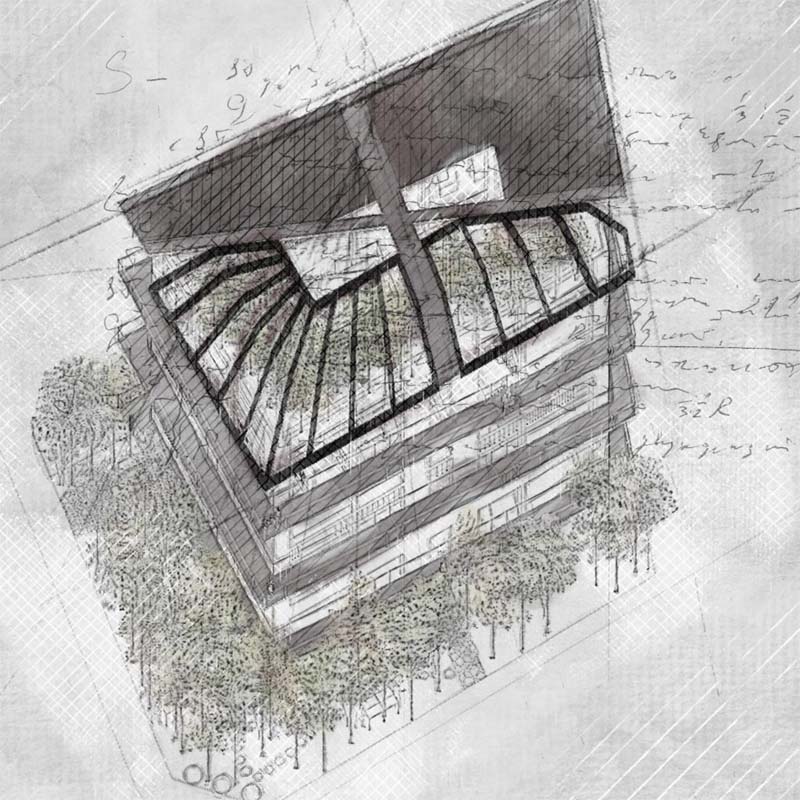



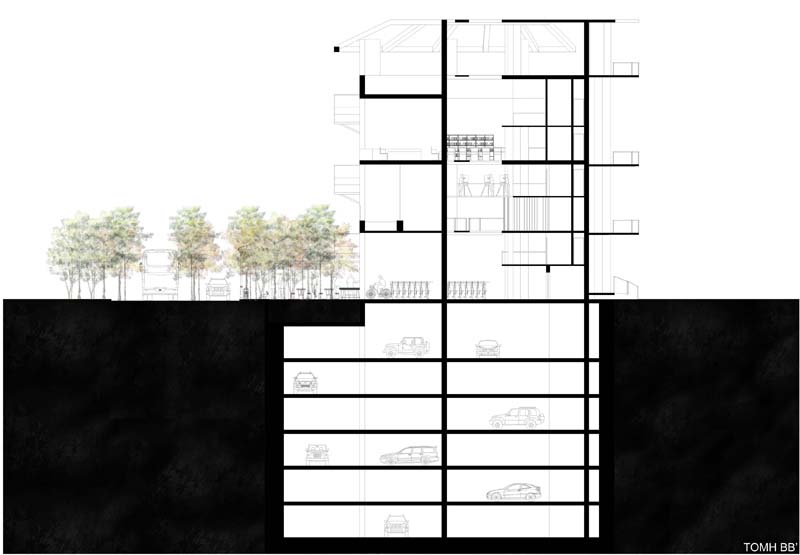

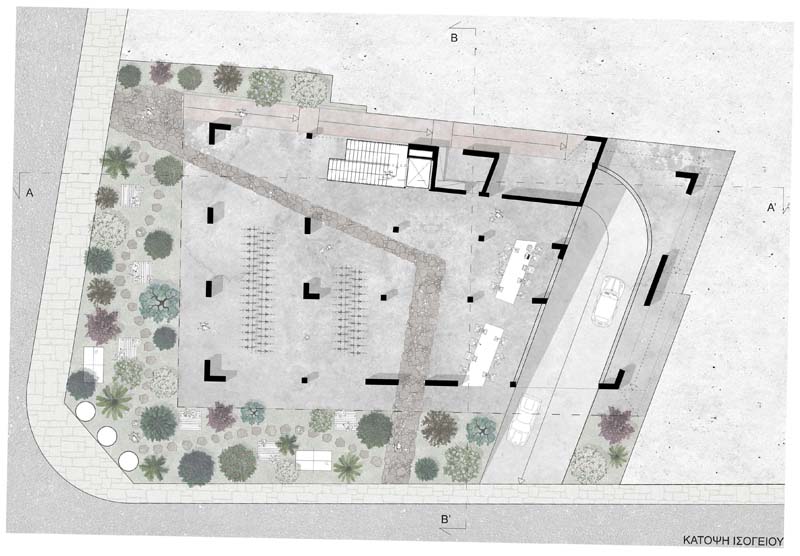

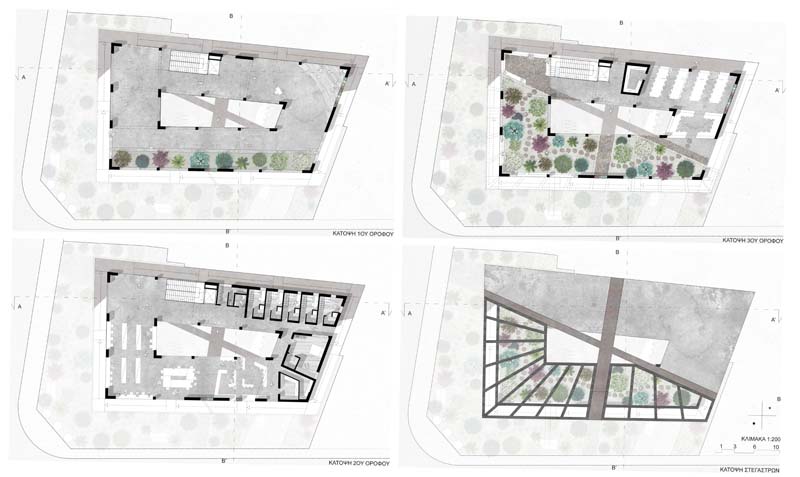



This dissertation is influenced by contemporary issues in the field of architecture, such as smart building, biophilic design and resilience, so its main objective is to design a building that is resilient to people, society and the city. The plot on which the proposal is based is located in the center of Volos, on the streets of Dimitriados and Philellinon. This location is strategically selected, since one of the objectives of the building is the gradual pedestrianization of the city center. This reinforces the need to create parking spaces in the city and thus I designed six levels of parking under the ground. My primary concern during the preparation of my dissertation was the design of an open building that would enable users or visitors to act freely in all directions, choose any activity they wish and directly interact with nature. On the ground floor there is public services and the rental of electric bicycles and skates, on the first floor there is an open exhibition space and an amphitheatre, on the second floor there are study areas, libraries and a shared kitchen, and also on these floors there are some auxiliary mezzanine floors. On the top floor there is the main green space of the building in combination with gardening workshops. The building includes a variety of green spaces as they serve the elegance of the building, the strengthening of the psychology of the users but also the avoidance of air pollution. Another important goal of diplomatic work was the freedom of movement at all levels without the forced entry on each floor separately. By designing a ramp around the building, the user has the opportunity to use this building as a vertical walk through the city, with the ultimate goal of enjoying a panoramic view of nature.
Supervisor: Remy Nicolas
Reference Number: 847

